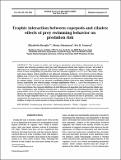Por favor, use este identificador para citar o enlazar a este item:
http://hdl.handle.net/10261/184316COMPARTIR / EXPORTAR:
 SHARE SHARE
 CORE
BASE CORE
BASE
|
|
| Visualizar otros formatos: MARC | Dublin Core | RDF | ORE | MODS | METS | DIDL | DATACITE | |

| Título: | Trophic interaction between copepods and ciliates: effects of prey swimming behavior on predation risk |
Autor: | Broglio, Elisabetta CSIC; Johansson, Mona; Jonsson, R. | Palabras clave: | Swimming behavior Predator-prey interaction Acartia clausi Copepods Ciliates |
Fecha de publicación: | sep-2001 | Editor: | Inter Research | Citación: | Marine Ecology Progress Series 220: 179-186 (2001) | Resumen: | The transfer of matter and energy in planktonic food webs is determined by the encounter rate between predators and prey and subsequent attack and capture success. We tested if differences in swimming behavior and escape ability of 2 planktonic ciliates could explain differences in their susceptibility to predation from the calanoid copepod Acartia clausi. We chose 2 similarly sized ciliates, which exhibited very different swimming behavior: Strobilidium spiralis (Strobilidiina) and Metacylis sp. (Tintinnina). Behavioral analyses were combined with feeding incubations. The behavior of S. spiralis was characterized by slow upward and downward swimming interrupted by sudden jumps. Metacylis sp. showed a swimming pattern typical for many tintinnids, with steep helical trajectories and without jumps. Feeding experiments while A. clausi was incubated in a 1:1 mixture of both ciliate species showed a higher predation rate on Metacylis sp. According to behavioral observations, the copepod exhibited a 2-fold difference in ingestion rate between the ciliate species. Furthermore, film analyses revealed that S. spiralis escaped the attacking predator with rapid jumps while Metacylis sp. lacked any effective behavioral response to the approaching predator. We discuss the relative importance of velocities and dispersal rates in encounter processes and conclude that the escape response shown by S. spiralis significantly reduces the risk of predation. This study emphasizes the importance of mechanistic knowledge at the level of behavior and individual sensory abilities to improve present models of biogeochemical fluxes in the water column | Descripción: | 8 pages, 1 figure, 4 tables | Versión del editor: | https://doi.org/10.3354/meps220179 | URI: | http://hdl.handle.net/10261/184316 | DOI: | 10.3354/meps220179 | Identificadores: | doi: 10.3354/meps220179 issn: 0171-8630 e-issn: 1616-1599 |
| Aparece en las colecciones: | (ICM) Artículos |
Ficheros en este ítem:
| Fichero | Descripción | Tamaño | Formato | |
|---|---|---|---|---|
| Broglio_et_al_2001.pdf | 90,62 kB | Adobe PDF |  Visualizar/Abrir |
CORE Recommender
SCOPUSTM
Citations
65
checked on 12-abr-2024
WEB OF SCIENCETM
Citations
59
checked on 26-feb-2024
Page view(s)
146
checked on 18-abr-2024
Download(s)
123
checked on 18-abr-2024
Google ScholarTM
Check
Altmetric
Altmetric
NOTA: Los ítems de Digital.CSIC están protegidos por copyright, con todos los derechos reservados, a menos que se indique lo contrario.
